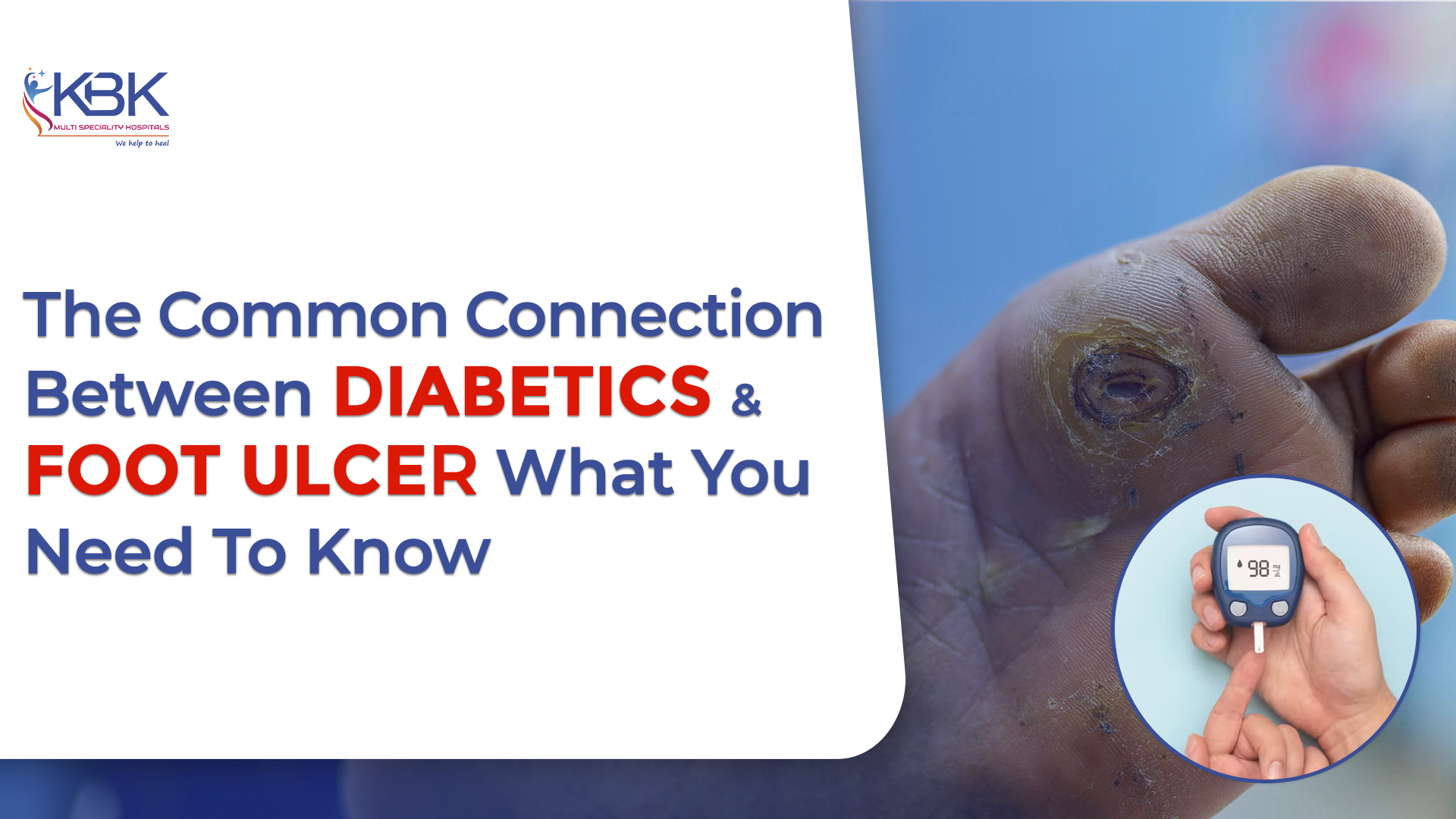People living with diabetes face many health challenges, but one of the most serious and often overlooked is the risk of diabetic foot ulcers. These open sores or wounds usually appear on the bottom of the feet and can become dangerous if left untreated. The connection between diabetes and foot ulcers lies in how high blood sugar affects nerves, blood flow, and the body’s ability to heal.
In this detailed blog, we’ll explore how diabetic foot ulcers develop, what causes them, early warning signs, and how proper care and prevention can help avoid complications.
Understanding Diabetic Foot Ulcers
A diabetic foot ulcer is an open sore or wound that occurs in people with diabetes due to poor blood circulation, nerve damage (neuropathy), or infection. These ulcers often begin as small cuts or blisters but can quickly worsen if blood sugar is not controlled.
Key facts about diabetic foot ulcers:
| Factor | Description |
| Location | Usually on the bottom of the foot, heel, or toes |
| Cause | High blood sugar leading to poor circulation and nerve damage |
| Risk Level | Increases with long-term or uncontrolled diabetes |
| Healing Time | Slower compared to non-diabetic wounds |
| Complications | Infection, gangrene, and tissue damage if untreated |
Why Diabetics Are More Prone to Foot Ulcers
People with diabetes are at higher risk of developing foot ulcers because of three main reasons:
Nerve Damage (Diabetic Neuropathy)
High blood sugar damages nerves, reducing sensation in the feet. You may not feel pain from a cut, blister, or injury, allowing wounds to worsen unnoticed.
Poor Blood Circulation
Diabetes narrows blood vessels, slowing blood flow to the feet. This makes it harder for wounds to heal and increases infection risk.
Weakened Immune System
High glucose levels can impair the body’s ability to fight infections, leading to severe diabetic foot infections.
How Diabetic Foot Ulcers Develop?
The process of ulcer formation often follows these stages:
- Minor Injury: A small cut, blister, or shoe friction damages the skin.
- Reduced Sensation: Due to neuropathy, the injury goes unnoticed.
- Poor Circulation: Blood flow restriction slows healing.
- Infection: Bacteria enter the wound, causing redness, swelling, and pus.
- Ulcer Formation: The wound deepens and may expose underlying tissue or bone.
Understanding these steps helps in early detection and faster treatment of diabetic foot ulcers.
Early Symptoms and Warning Signs
Recognizing the early signs of diabetic foot ulcers can help prevent severe complications.
Common symptoms include:
- Swelling or redness in the foot
- Persistent pain or tenderness
- Fluid or discharge from a wound
- Foul odor
- Black or dead tissue (a sign of poor blood flow)
- Numbness or tingling in the feet
If any of these symptoms appear, it’s essential to seek medical help immediately.
Risk Factors for Diabetic Foot Ulcers
Not everyone with diabetes will develop foot ulcers, but certain factors increase the risk.
| Risk Factor | Explanation |
| Uncontrolled blood sugar | High glucose slows wound healing |
| Smoking | Reduces circulation and oxygen delivery |
| Foot deformities | Pressure points cause skin breakdown |
| Improper footwear | Tight shoes lead to blisters and sores |
| Long-term diabetes | Increases nerve and vessel damage |
| Poor hygiene | Promotes bacterial infections |
Stages of a Diabetic Foot Ulcer
Foot ulcers are classified based on their severity:
| Stage | Description | Condition |
| Stage 1 | Red area or callus | Early warning |
| Stage 2 | Open sore or wound | Superficial damage |
| Stage 3 | Deep ulcer involving tissue | Risk of infection |
| Stage 4 | Bone involvement or gangrene | Severe and dangerous |
Early treatment during Stage 1 or 2 can prevent major complications.
Treatment Options for Diabetic Foot Ulcers
Managing diabetic foot ulcers requires a combination of wound care, infection control, and blood sugar management.
A. Wound Care
- Clean the ulcer daily with mild antiseptic.
- Keep the wound covered with sterile dressing.
- Avoid walking barefoot to reduce pressure.
B. Infection Control
- Use prescribed antibiotics if infection is present.
- Seek medical care for any signs of pus, odor, or redness.
C. Pressure Relief (Offloading)
Reducing pressure on the affected foot helps healing. Doctors may recommend special footwear, soft shoes, or padding.
D. Blood Sugar Management
Maintaining a normal blood sugar level speeds up healing and prevents new ulcers.
Prevention Tips for Diabetic Foot Ulcers
Prevention is the best approach for people with diabetes. Small daily habits can go a long way in protecting your feet.
Essential prevention tips:
- Inspect your feet daily for blisters, cuts, or swelling.
- Wash your feet regularly with mild soap and warm water.
- Dry feet thoroughly, especially between toes.
- Wear properly fitted shoes and soft cotton socks.
- Avoid walking barefoot.
- Trim nails carefully or seek professional help.
- Maintain good blood sugar control.
- Schedule regular foot checkups with your doctor.
The Role of Blood Sugar in Foot Ulcer Healing
High blood sugar weakens the immune system and damages blood vessels, which slows the healing process. Maintaining balanced glucose levels ensures better circulation, improved tissue repair, and reduced infection risk.
Here’s a quick comparison:
| Blood Sugar Level | Healing Ability | Infection Risk |
| Normal | Fast healing | Low |
| Moderately High | Delayed healing | Moderate |
| Very High | Poor healing | High |
Proper diabetes management is the foundation of foot health.
When to See a Doctor
You should seek immediate medical attention if you notice:
- A wound that isn’t healing
- Discoloration or swelling
- Pus or foul odor
- Numbness, pain, or tingling
Delaying treatment can increase the risk of infection and further tissue damage.
Long-Term Care for Diabetic Feet
Long-term foot care is essential to prevent recurrence of diabetic foot ulcers.
Care recommendations:
- Attend routine diabetic foot examinations.
- Follow a nutritious diet that supports circulation.
- Engage in low-impact exercises like walking or swimming.
- Avoid smoking or alcohol, which affect blood flow.
- Keep your blood sugar within your doctor’s recommended range.
Consistent care helps keep your feet healthy and lowers the chance of future ulcers.
Myths and Facts About Diabetic Foot Ulcers
| Myth | Fact |
| Foot ulcers are not serious. | Untreated ulcers can become life-threatening. |
| Only older diabetics get ulcers. | Anyone with diabetes can develop them. |
| Ulcers heal on their own. | They require medical care to prevent infection. |
| Proper shoes don’t matter. | Well-fitted footwear helps prevent pressure wounds. |
| Blood sugar doesn’t affect foot ulcers. | High glucose levels directly slow wound healing. |
Conclusion
Diabetic foot ulcers are a common yet preventable complication of diabetes. Understanding how they form and taking proactive measures can make a big difference in protecting your health. Regular foot inspections, maintaining normal blood sugar levels, and seeking prompt medical attention for any signs of injury are key to keeping your feet healthy.
With proper care, awareness, and support from medical professionals, you can significantly reduce your risk of developing diabetic foot ulcers and maintain a better quality of life.
Frequently Asked Questions (FAQs)
1. What causes diabetic foot ulcers?
Diabetic foot ulcers occur due to poor circulation, nerve damage, and high blood sugar levels that delay healing and increase the risk of infection.
2. How can I tell if I have a diabetic foot ulcer?
Look for redness, swelling, open sores, foul odor, or black tissue on your foot. If you notice any of these signs, seek medical advice immediately.
3. Can diabetic foot ulcers heal completely?
Yes, with proper care, blood sugar control, and medical treatment, diabetic foot ulcers can heal. However, recovery time varies depending on severity and circulation.
4. How do I prevent diabetic foot ulcers?
Maintain healthy blood sugar, inspect your feet daily, wear comfortable shoes, and avoid walking barefoot. Regular checkups with a podiatrist are essential.
5. Are diabetic foot ulcers painful?
Not always. Nerve damage (neuropathy) may cause numbness, so many people don’t feel pain even with severe ulcers.
6. What happens if a diabetic foot ulcer is left untreated?
Untreated ulcers can become infected and lead to severe complications like tissue damage or gangrene. Early medical care prevents these risks.



